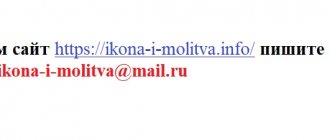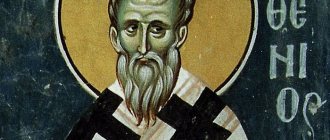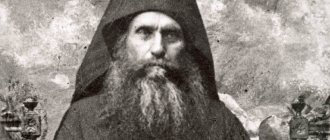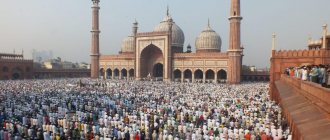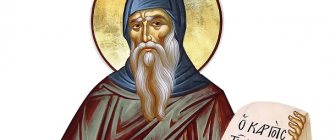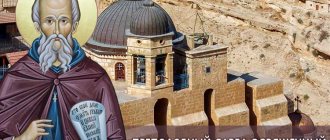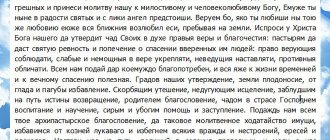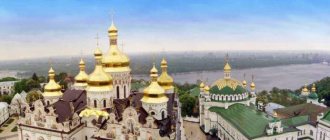Seraphim (Sobolev)
Sobolev Nikolay Borisovich
1881-1950
Russian Orthodox Church
San: archbishop
Type: Holy Russian Orthodox Church
Graduated from: Ryazan Theological School, Ryazan Theological Seminary, SPbDA
Taught at: Kaluga Theological School, Kostroma Theological Seminary, Voronezh Theological Seminary, Taurida Theological Seminary
Influenced by: Parfeniy (Stamatov)
Direction: anti-modernism
Personalities
Saint Seraphim
(Archbishop Bogucharsky, in the world -
Nikolai Borisovich Sobolev
; December 1 (14), 1881 - February 26, 1950) - saint, Orthodox Russian theologian and anti-modernist. A fighter against ecumenism, sophiology, moral monism, and the New Calendar schism.
education
In 1894 he entered the Ryazan Theological School. Graduated from the Ryazan Theological Seminary. In 1904 he entered the St. Petersburg Theological Academy. Repeatedly visited St. right John of Kronstadt[1].
Together with Ivan Fedchenkov and Viktor Raev, he took part in the creation, under the leadership of Archimandrite Feofan (Bistrov), of the “Zlatoust Circle”, the purpose of which was to study and interpret the patristic works. Initially there were only five people in the circle. As Metropolitan Veniamin (Fedchenkov) later recalled, those who attended the circle “developed an Orthodox fatherly outlook. That was the goal"
[2]:22.
At the beginning of 1908, he was tonsured a monk with the name Seraphim (in honor of St. Seraphim of Sarov) and ordained a hierodeacon, and later to the rank of hieromonk. In the fall of 1908, Fr. Seraphim defended his Ph.D. thesis “The Teaching of Humility according to the Philokalia”
[2]:29-31.
Among brothers in faith
Arriving in Sofia in the spring of 1921, he first received the appointment of Bishop of Bogucharsky, and soon became rector of the former embassy church and dean of Russian Orthodox parishes. Here, in the Bulgarian capital, he continues his feat of serving God, just as zealously fulfilling the obediences entrusted to him, as he once did in Russia.
In 1935, the future Saint Seraphim was elevated to the rank of archbishop. It was in the thirties that his extensive activity as a theologian and publicist began. In 1935, his works were published, in which the saint entered into a theological debate with such recognized authorities of religious philosophy as V. Solovyov, P. Florensky and S. Bulgakov.
teaching activity
He began his teaching career in 1908 at the Pastoral School named after John of Kronstadt, created by Archbishop Anthony (Khrapovitsky) of Volyn and Zhitomir in his diocese. Due to deteriorating health, in the same year he applied for a transfer and was appointed assistant superintendent of the Kaluga Theological School. During the period of work at the school, he repeatedly visited Optina Pustyn, where he became close to St. Anatoly Optinsky, who became Fr. Seraphim.
In 1911, he was assigned to the position of inspector of the Kostroma Seminary.
Archimandrite Seraphim is the rector of the Voronezh Theological Seminary and teachers. 1914
In December 1912, by determination of the Holy Synod, he was appointed rector of the Voronezh Theological Seminary and elevated to the rank of archimandrite. He served as rector until the seminary was closed by Soviet authorities in 1918. Work about. Seraphim at the Voronezh Seminary was highly appreciated, in particular, by P. F. Polyansky. In Voronezh, Archimandrite Seraphim also became the editor of the Voronezh Diocesan Gazette and a permanent member of the diocesan educational council.
Since 1913, he was a member of the council of the Voronezh Brotherhood of Saints Mitrofan and Tikhon, which was engaged in conducting extra-liturgical interviews and readings, teaching parishioners the general singing of church hymns, distributing brochures and leaflets. In the same year, thanks to Fr. Seraphim, the St. John the Theological Brotherhood at the seminary began its work, providing financial assistance to students of the seminary who did not have money to pay for tuition, purchase clothes, treatment, or pay for trips home.
With the outbreak of the First World War, he headed the Committee for Refugees from the Western Regions of Russia [2]: 32-36.
In December 1919, while in the South of Russia, which was occupied by white troops, he was appointed rector of the theological seminary in Yekaterinoslav, but could not begin to fulfill his duties, since Yekaterinoslav was at that moment occupied by the Makhnovists.
On May 7, 1920, by determination of the Temporary Higher Church Administration No. 606, he was appointed rector of the Tauride Seminary[2]:42-43.
Ordained a bishop on the Feast of the Intercession of the Most Holy Theotokos in 1920, shortly after the evacuation from Crimea and arrival in Constantinople, he taught dogmatic theology for some time at the Higher Theological School of the Ecumenical Patriarchate on the island of Halki[2]:47, 50, 51.
Work in the rebel seminary
He held the position of rector until 1918, but already at the very beginning of his activity he encountered the first signs of a future catastrophe. It is well known that one of the driving forces towards the overthrow of the monarchical system that existed in Russia at that time was the students.
This is not surprising. Young, easily susceptible to new, sometimes outwardly spectacular and attractive social ideas, students often became toys in the hands of political adventurers. Oddly enough, this equally applied not only to students of Soviet universities, but also to students of religious educational institutions who took an active part in political strikes and demonstrations.
Students of the Voronezh Seminary, whose rector was Archimandrite Seraphim (Sobolev), were no exception. Moreover, even before his appointment to this position, the educational institution “became famous” throughout Russia for the fact that its students attempted to assassinate the previous rector and inspector. A letter to Father Seraphim has been preserved from one of his colleagues, in which he, sympathizing with the newly appointed rector, calls this seminary “the most hopeless” and “rebellious.”
hierarchy and service
On January 26 (February 8, New Art.), 1908, Bishop Sergius (Tikhomirov) of Yamburg tonsured him into monasticism with the name Seraphim.
On February 3 (16), 1908, he was ordained hierodeacon.
On March 18 (31), 1908, he was ordained hieromonk[2]:29, 30[1][3].
At the end of 1912, being by that time in the rank of abbot[4], he was elevated to the rank of archimandrite[2]:34.
In the summer of 1915, at the Annunciation Mitrofan Monastery, he harshly denounced atheists, heretics, sectarians and other false teachers, as well as their followers[4].
On October 1 (14), 1920, in Simferopol, he was consecrated Bishop of Lubensky, vicar of the Poltava diocese. The initiator of the episcopal ordination of Father Seraphim was earlier initiated by Archbishop Feofan (Bistrov); the consecration was also performed with the participation of Bishop Theophan [2]: 44-46, 147 [3].
On November 1 (14), 1920, on the last steamship leaving Sevastopol, the Chersonesos left Russia and emigrated to Constantinople[3][2]:50.
In the spring of 1921, the administrator of Russian parishes in Western Europe, Archbishop Eulogius (Georgievsky), appointed Bishop Seraphim as rector of the Russian Church of St. Nicholas the Wonderworker on Tsar Liberator Boulevard in the city of Sofia; this decision was confirmed by the Supreme Russian Church Administration Abroad (HRCUZ). In May 1921, Bishop Seraphim moved to Bulgaria. In August of the same year, the VRCUZ appointed Bishop Seraphim as administrator of the Russian Orthodox communities in Bulgaria, reserving for him the post of rector of the St. Nicholas Church. There is unconfirmed information that earlier decisions of the VRCUZ, in April, May or August 1921, St. Patriarch Tikhon appointed Bishop Seraphim as manager of all Russian Orthodox communities in Bulgaria with the rights of a diocesan bishop[2]:52-56[5]:22[1].
Probably, in October 1921, Saint Tikhon changed the title of Bishop Seraphim to “Bogucharsky”. The city of Boguchar was located in the Voronezh province, while Archimandrite Seraphim received the blessing of His Holiness the Patriarch for consecration as the second vicar of the Voronezh diocese back in 1919; however, this ordination did not take place then. Until 1930, in documents the ROCOR was referred to as “Bishop of Lubensky,” since the new title did not immediately become known in emigration [2]: 41, 55.
In addition to the St. Nicholas Church, the parishes in Varna, Plovdiv, Pernik, Ruse (Ruschuk), Peshtera, Tsarebrod (near the city of Shumen), Knyazhevo (a suburb of Sofia) and Shipka, as well as the monasteries of Yambol of the Holy Savior (Alexandro -Nevsky) and Asenovgrad Saints Kirik and Iulita[2]:57, 58.
Despite his serious illness (tuberculosis), Bishop Seraphim strictly performed all the required services. He launched extensive charitable activities at the St. Nicholas Church in favor of disabled parishioners, Russian emigrants, and Russian Athonite monasticism[2]:60.
Soon after arriving in Bulgaria, he facilitated the move to this country of Archbishop Feofan (Bistrov)[2]:62.
At the end of 1921, he took part in the Russian All-Foreign Church Council in Sremski Karlovci, Kingdom of Serbs, Croats and Slovenes. Speaking at the Council, Bishop Seraphim noted the harm caused by the propaganda of Baptistism and Adventism among emigrants, as well as public organizations where, under the guise of Christianity, occult ideas and atheism were instilled in young people. Another problem that Bishop Seraphim drew attention to was the propaganda of Catholicism, aimed, in addition to Russia, at Russian emigration. Regarding Russia, Bishop Seraphim drew attention to the fact that Rome tried to take advantage of the plight of the Russian Church for its mission. Regarding Russian emigration, the bishop noted[2]:63, 64:
“The propaganda of Catholicism is carried out among influential or rich Russian adults and among the children of poor Russian refugees. Catholics willingly place the latter in their boarding schools, paying special attention to the educational part. There are known cases of fantasized young children converting to Catholicism at their own insistence. In all major cities of Europe and in areas of refugee settlement, there are Catholic boarding schools for Russians, which threatens to create a cadre of Russian Catholics in the future.”
[6].
At the Council, he proposed a number of measures aimed at the success of the preaching of Orthodoxy, countering the propaganda of Catholicism, sectarianism and dubious youth organizations; appealed to Metropolitan Anthony on the issue of the speedy accession to the Church of the Old Believers-Priests who expressed such a desire [2]: 65, 66.
Supported the adoption of the message “To the Children of the Russian Orthodox Church in Dispersion and Exile” in its “monarchical” edition. It should be noted that later in one of his works, Bishop Seraphim wrote that “... one of the foundations of the revival of Russia is the primordial royal autocratic power of the Anointed of God; that no other form of government is acceptable for Russia, because it is incompatible with the Orthodox faith and is not based on it”
[7]. At the same time, Bishop Seraphim called socialism a “devilish teaching”[8] and believed that the Church should condemn it in all its forms, as fundamentally contrary to Christianity[9].
In 1927, like most other Russian bishops abroad, he signed the “District Epistle” of the ROCOR Council of Bishops, condemning the “Declaration” of Metropolitan Sergius (Stragorodsky)[3]. He sharply criticized Metropolitan Sergius and the policy of recognizing godless power in general; believed that such recognition sanctioned “countless atrocities <...> for the destruction of our Russian Orthodox people and our Russian Orthodox Church”
[2]:88, 89, 91[10].
He paid special zealous attention to maintaining the purity of Orthodox doctrine, adhering to principled and strict views in relation to sophiology, ecumenism, and the calendar issue[3]. From the mid-20s, together with Archbishop Feofan (Bystrov), he opposed the attempts of the Synod of Bishops of the ROCOR to replace the Catechism of St. Philaret with the catechism of Metropolitan Anthony (Khrapovitsky) - one of the fundamental works of moral monism[11]; Archbishop Theophan, on his own behalf and on behalf of Bishop Seraphim, speaking at one of the meetings of the ROCOR Synod of Bishops in 1927, presented their reports against the teachings of Metropolitan Anthony and directly appealed to the latter with a request not to disseminate this teaching [2]: 98-101. The serious influence exerted on attempts to spread these non-Orthodox views was also noted by their adherents[12]
The result of the activities of Bishops Theophan and Seraphim was also the condemnation of the teachings of Archpriest Sergius Bulgakov: in March 1927, the Synod of Bishops of the ROCOR published a message denouncing the “modernist spirit”
Paris St. Sergius Institute;
The message condemned the teaching about Sophia of Archpriest Sergius as a “new dogmatic teaching”
[2]: 123.
Church of St.
Nicholas the Wonderworker, in which Saint Seraphim served, treated Tsar-Martyr Nicholas Alexandrovich with special respect, calling him “kind and Orthodox”
. Not wanting to believe in the death of the Sovereign, like Archbishop Theophan and other clergy, until 1927 (when the ban of the Council of Bishops of the ROCOR followed) he served solemn prayers for the health of the Royal Family, for which he was subjected to ridicule from ill-wishers[13][2]:163 -165.
At the end of 1929, he turned to the Synod of Bishops of the ROCOR with a request for permission to “call himself henceforth Bogucharsky”
, which would indicate the appointment of Bishop Seraphim
“to the Boguchar See by the main central authority of the Russian Church”
[14]. The request was granted, and later Vladyka Seraphim was mentioned with the title “Bogucharsky”[2]:147.
In the 1920s he helped overcome the so-called “Bulgarian schism.” As Metropolitan Paisiy of Vrachansky later testified, it was Bishop Seraphim who at one time helped the Bulgarian Church to take its rightful place in the family of Local Churches[2]:172, 173.
There is evidence that during his stay in Sofia, the head of the YMCA, John Mott, expressed his negative attitude towards this organization [2]: 209, 211.
In 1930, during a speech at the Congress of Russian Scientists in Sofia, he publicly condemned those scientists who did not consider it necessary to place the Orthodox faith as the basis of their scientific views[2]:119.
In 1933-1934, he protested several times against the planned participation of the ROCOR bishop in the “interreligious conference on the fight against unbelief,” which envisaged joint prayer of Orthodox Christians with heretics, Mohammedans, Judaists and pagans. Bishop Seraphim insisted that the participation of representatives of the Orthodox Church in such “conferences” contradicts the Holy Scriptures and canons. As a result of the protests, the previously received permission from the ROCOR Synod of Bishops for one of the bishops to participate in the “conference” was cancelled[2]:211.
In 1934, in connection with the establishment of diplomatic relations between Bulgaria and the USSR, property issues were resolved, while the Soviet side demanded the transfer of Russian church property in Bulgaria to the USSR. However, in the end, including through the efforts of Bishop Seraphim, a different decision was made: the Soviet side agreed to transfer the St. Nicholas Church in Sofia, the Church of the Nativity on Shipka and the Yambol Monastery for temporary use to the “Bulgarian people” on the condition that they would be governed by the Bulgarian Church without the participation of Russian emigrants. In the fall of 1934, the St. Nicholas Church on Tsar Liberator Boulevard was transferred to the Sofia Metropolis, and the Bulgarian Orthodox Church transferred the St. Nicholas Church on Tsar Kaloyan Street to the Russian community; this temple became the place of the main ministry of Bishop Seraphim. He continued to manage the temple on Shipka and the Yambol monastery until the summer of 1935 [2]: 68-71.
In 1934, the Council of Bishops of the ROCOR elevated him to the rank of archbishop[2]:72.
In the 1930s, he corresponded with Metropolitan Eleutherius (Epiphany) and Archbishop Veniamin (Fedchenkov), who were under the jurisdiction of the Moscow Patriarchate. In the mid-1930s, he sent three copies of his book “New Teaching about Sophia the Wisdom of God” to Moscow, and sent them specifically to Metropolitan Sergius[1].
At the Council of Bishops of the ROCOR in 1935, which recognized the teaching of Archpriest Sergius Bulgakov about Sophia as a heresy, he denounced this teaching. He was a member of the Council commission created to make a decision on Sophianism [2]: 121-123, 125.
By the fall of 1936, he prepared for the Council of Bishops of the ROCOR a new essay, “Defense of the Sophian heresy by Archpriest S. Bulgakov in the face of the Council of Bishops of the Russian Church Abroad.” This essay was a refutation of the “Memorandum” of Archpriest Sergius, submitted to Metropolitan Evlogy at the beginning of 1936; the “Memorandum” contained objections to the condemnation of Sophianism. The Council of Bishops in 1936 again recognized the teaching of Archpriest Sergius as heretical, and himself as being in delusion [2]: 127, 128.
He fought against the spread of false teachings and sects of an occult and chiliastic nature. Finding almost no support either from the hierarchs of the Bulgarian Church or from the state, Archbishop Seraphim and his supporters denounced false teachings with the help of sermons and the printed word[2]:130-132.
In 1937, with the blessing of Archbishop Seraphim, courses on combating godlessness were opened in Varna[2]:132.
On January 1, 1938 (December 19, 1937, O.S.), for the essay “New Teaching on Sophia the Wisdom of God,” the Academic Committee of the ROCOR Synod of Bishops awarded him the academic degree of Master of Theology. A few days later, this decision was approved by the Synod, after which Bishop Seraphim was included in the Academic Committee[2]:129.
In August 1938, at the Second All-Diaspora Council of the ROCOR in Sremski Karlovci, he made a report on the ecumenical movement, in which he spoke about the inadmissibility of the participation of the Ecumenical Orthodox Church in this movement, about its complete dependence on Freemasonry[3]. In his report “The Moral Basis of Sophianism,” Bishop Seraphim emphasized the danger of Sophianism and drew attention to the fact that it is the fruit of atheistic humanism, popular among the intelligentsia. In addition, in his report, the bishop noted the danger of looking at theological science as “an external authority in relation to the dogmas themselves.”
[2]: 119, 120, 129, 130. He opposed cooperation with the organization “Christian Labor Movement,” whose leaders were ready to provide material assistance to the ROCOR Synod of Bishops in exchange for an official blessing for their organization;
thanks to the firm position of Archbishop Seraphim, the “deal” did not take place [2]: 212, 213. Archbishop Seraphim (Sobolev) with the clergy and believers
At the Council, representatives of a number of dioceses of the ROCOR turned to Bishop Seraphim with a request to “give them information regarding Russian ideology and, in particular, the rationale tsarist autocratic power"
.
The result of these appeals was the essays “Russian Ideology”
and
“On the True Monarchical World Outlook”
[2]: 213, 214.
In the fall of 1941, he tried to visit Russia for missionary purposes and turned to the Synod of the Bulgarian Church with a request for help in organizing spiritual life in the territories occupied by Germany. Despite the Synod’s support for the “deliberate mission”
to Russia to provide
“material and moral assistance to the local Russian clergy in restoring liturgical and normal church life in general everywhere
,” Archbishop Seraphim’s trip did not take place due to opposition from the German authorities.
He tried to send literature and liturgical objects to Russia, often (also due to the opposition of the German authorities) through illegal means [2]: 175, 176. During the war, he refused to bless the White emigrants to fight against Russia, which caused their discontent [2]: 177. According to one of the testimonies, “in 1943 he sharply separated from Metropolitan Anastassy, refusing to participate in the Vienna Council, which was led by the Germans”
[5]:22. There is other similar evidence, as well as evidence to the contrary. It is reliably known that Bishop Seraphim did not participate in the Bishops’ Conference of the ROCOR in Vienna and did not sign any of its documents [2]: 178-180. After the destruction of the St. Nicholas Church on March 30, 1944 during the Anglo-American bombing, the Bulgarian Church handed over two churches to the Russian community: St. VMC. Catherine in Knyazhevo (in May) and St. prmts. Paraskeva Samardzhiyskaya on Maria Louise Boulevard (in August); Bishop Seraphim served mainly in these churches[2]: 180, 181.
In February 1945, along with a greeting to the Local Council of the Russian Orthodox Church, he sent his books “New Teaching about Sophia the Wisdom of God” and “Archpriest S. N. Bulgakov as an Interpreter of the Holy Scriptures” to Moscow to the future Patriarch Alexy I. Later, in a letter to the elected Patriarch, he asked that the matter of condemning the false teaching of Archpriest Sergius Bulgakov be brought to an end[2]:183.
On October 30, 1945, together with seven parishes, it was accepted into the jurisdiction of the Moscow Patriarchate; Bishop Seraphim, who reported directly to the Patriarch of Moscow and All Rus', was entrusted with the management of these parishes[2]:191.
In May 1946, he met with Patriarch Alexy I during his visit to Bulgaria. On May 22, at a solemn service performed by the Patriarch in the restored St. Nicholas Church, Bishop Seraphim delivered a sermon in which, in particular, he said:
“Just as you suffered grievously from the modernists, living churchmen and renovationists, so we shared your mental anguish, not approving or allowing any innovations in the Church. Just as you were against all heresies, so we have always been against all dogmatic deviations. Both for you and for us, the Orthodox faith is the highest and most precious good.”
[15].
On June 14, 1946, Archbishop Seraphim was granted USSR citizenship. In 1948 he visited the Soviet Union, where he took part in the Pan-Orthodox Conference in Moscow. At the Meeting I read three reports: on the ecumenical movement, on the church calendar and on the Anglican hierarchy [2]: 192, 195, 203.
In a report on the topic “Does the Russian Orthodox Church need to participate in the ecumenical movement?” Bishop Seraphim consistently defended his earlier expressed (in particular, at the Second All-Diaspora Council of the ROCOR) attitude towards ecumenism, expressed the desire that the Russian Orthodox Church would have nothing in common with ecumenism, and denounced the “Orthodox” ecumenists:
“Finally, one cannot help but pay attention to the negative significance of the participation of Orthodox representatives at ecumenical conferences. The very fact of this presence confirms heterodox Christians in their thought that all Christian confessions belong to the One Ecumenical Orthodox Church. We believe that this presence does not at all mean that heterodox Christians began to belong to the true Church of Christ. No matter how far they were from the Orthodox Church in their religious errors, they remained so. The presence of Orthodox representatives at ecumenical conferences only indicates that Orthodox Christians have begun to retreat from their Orthodoxy. It is difficult to say where the more Orthodox ecumenists deviate from the Orthodox Church—either in their writings, or in their presence at ecumenical conferences? This presence is in its essence a betrayal of our Orthodox dogmatic teaching about the Church, expressed in the ninth member of the Creed. By attending the heretical meeting, which ecumenists call the “All-Church Conference”, “the meeting of all Christian churches” and the “one holy Church of Christ,” Orthodox representatives thereby actually affirm the existence of this “one holy Church of Christ” with all its heretical errors.”
[5]:25[16].
The report “On the New and Old Style” examined possible changes in church services in the event of the introduction of a new calendar style and their contradiction to the Church Charter, the covenants of the Holy Fathers and the established liturgical tradition[3]. It should be noted that Archbishop Seraphim was not satisfied with the resolution adopted by the Conference on the issue “On the Church Calendar” [2]: 221, which, on the one hand, confirmed the inviolability of the Alexandrian Paschal, and on the other, expressed the opinion “that for fixed holidays, each autocephalous The Church can use the calendar existing in this Church.”
, and that
“the Council considers it obligatory for clergy and laity to follow the style of the local Church within which they live, as one of the customs of this Church, the observance of which in the name of unity and love the holy canons command us”
[17].
In 1948, it was planned to appoint Archbishop Seraphim as the ruling bishop of the Western European Exarchate of the Russian Orthodox Church; this appointment did not take place[2]:224-226.
Saint Seraphim Bogucharsky
In the 1940s he made every possible effort to counter modernist trends in the Bulgarian Church. Characterizing what was happening, Archbishop Seraphim, in one of his letters to Patriarch Alexy, wrote, in particular:
“All metropolitans are resolute followers of ecumenism, both before and after the Moscow Conference... If ecumenical disintegration continues to proceed in the same steps, then the day is not far off when the leaders of the Bulgarian Church will lead it, to the delight of the enemies of Orthodoxy, to complete spiritual unity with the established in the West, religious unity, which, in the person of ecumenism, sets as its task the absorption of all Local Orthodox Churches and the formation of a single universal church that is not Orthodox, but ecumenical, i.e., heretical and Masonic, which is the essence of ecumenism.”
[18].
In 1949, he published an article in the printed organ of the Synod of the Bulgarian Church directed against ecumenism, modernism, second marriage of the clergy, and belittling the role of the Synod in church governance due to the promotion of white clergy. Later, Bulgarian bishops noted that Bishop Seraphim’s speech in the press helped stop the renovationist turmoil that was flaring up in the Bulgarian Church [2]: 227-231.
In December 1949, he received permission to found the Knyazhevsky Convent in honor of the Intercession of the Blessed Virgin Mary[1][3].
Since the late 1940s, he was often ill, and suffered a serious loss in 1948 - the death of his younger brother Archimandrite Sergius. On February 26, 1950, on the feast of the Triumph of Orthodoxy, Bishop Seraphim died. On March 1, a funeral service was held, led by Metropolitan Paisiy of Vrachansky, after which Archbishop Seraphim was buried in the crypt of the St. Nicholas Church [2]: 227, 236, 237.
Even during the life of Vladyka Seraphim, many saw in him a saint of God[2]:73, 74. As one of the Vladyka’s acquaintances noted:
“I testify, daring to affirm: Vladyka Seraphim abundantly exuded the grace of God, the strongest and constant bearer of which he was without any doubt.”
[19].
After the repose of Archbishop Seraphim, sufferers began to flow into his tomb, receiving consolation and healing after prayers in front of his tomb. There are numerous cases of miraculous help through the prayers of the Bishop [2]: 237, 239 [20].
On February 3, 2016, the Russian and Bulgarian Churches glorified Archbishop Seraphim (Sobolev) as a saint[21].
Forced emigration
After the October Revolution and with the outbreak of the Civil War, Archimandrite Seraphim, relinquishing his rectoral duties and interrupting his cooperation with the editors of the Diocesan Gazette, went to the south of Russia. There he comes at the disposal of the church power structure formed by the church council held in Stavropol in 1919. Its creation was caused by the fact that large areas of the south of the country were cut off from the highest church leadership by the fronts of the Civil War.
In October 1920, in Simferopol, under the roar of the guns of the advancing Red Army, Archimandrite St. Seraphim (Sobolev) was elevated to the rank of bishop. This was his last consecration in his native land. On September 14 he sailed to Constantinople. Forty years of life spent in Russia were left behind; years of emigration lay ahead.
major works
- Seraphim (Sobolev), St.
Humanistic and frank views on the future order of earthly life (1906) - Archbishop's statement Feofan and Bishop Seraphim on the autocephaly of the Polish Church // GA RF. F. 6343. Op. 1. D. 6. L. 36-37
- Special opinion of the archbishop. Feofan and Bishop Seraphim about Metropolitan Plato // GA RF. F. 6343. Op. 1. D. 6. L. 292-293
- Seraphim (Sobolev), St.
About the catechism of Metropolitan. Anthony (Khrapovitsky). August 12, 1925 // Personal archive of R. A. Vershillo. - Seraphim (Sobolev), St.
New teaching about Sophia, the Wisdom of God (1935) - Seraphim (Sobolev), St.
Archpriest S. N. Bulgakov as an interpreter of the Holy Scriptures (1936) - Seraphim (Sobolev), St.
Defense of the Sophian heresy by Archpriest. S. Bulgakov in front of the Council of Bishops (1937) - Seraphim (Sobolev), St.
Akathist to our venerable and God-bearing father John, desert dweller of Rylsky, wonderworker (1938) - Seraphim (Sobolev), St.
Russian Ideology (1939) - Seraphim (Sobolev), St.
Distortion of Orthodox truth in Russian theological thought. - Sofia, 1943. - Seraphim (Sobolev), St.
Does the Russian Orthodox Church need to participate in the ecumenical movement? // Acts of the Conference of Heads and Representatives of Autocephalous Orthodox Churches: In 2 volumes - M.: Moscow Patriarchate, 1949. - T. 2. - 364-368 p. - Seraphim (Sobolev), St.
On New and Old Style (1948) - Seraphim (Sobolev), St.
On the issue of the union of the Anglican Church with the Orthodox Church (1948)
On a foreign shore
During that period, Constantinople became a refuge for many who, fleeing the senseless and merciless rage of the Bolsheviks, intoxicated by victory, left Russia. Finding themselves in a foreign country, without connections, without knowledge of the language, and often without money, people needed the warm and sincere word of a shepherd, capable of comforting and giving strength to those whom they left behind. St. became such a spiritual leader among them. Seraphim (Sobolev), who himself found himself in an equally difficult situation.
The wave of Russian emigration that rushed to Constantinople in 1920 began to gradually spread throughout the world by the next year. Together with his compatriots, Bishop Seraphim also left the shores of the Bosphorus. He headed his way to Bulgaria, where, despite the long period of Turkish yoke, long-standing Orthodox traditions had historically developed.
A bold initiative
An important event in the life of Bishop Seraphim was his written appeal, sent in April 1945 to the USSR, Patriarch Alexy I. In it, he stated a request to be accepted into the Moscow Patriarchate. Considering the gulf that separated religious figures in emigration in those years from their brothers in Christ fulfilling their pastoral duty in the Soviet Union, one can imagine how much mental strength this decision cost him.
An issue of this level could only be resolved by Stalin. In a memorandum addressed to him, Archbishop of Pskov Gregory (Chukov), who visited the Bulgarian Church shortly before, described Bishop Seraphim as a narrow-minded person, politically illiterate, although he was loved by parishioners. This characterization can hardly be fully considered objective, given that it was written for the head of a totalitarian state, and it spoke about an emigrant, that is, by the standards of that time, a traitor to the homeland.
Statements that shocked the public
In his statements, Bishop Seraphim was sometimes extremely radical. For example, many readers were perplexed by his idea of applying the death penalty to individuals who promote atheism and are convicted of blasphemy. It is difficult to say how the author reconciled such views with the principles of Christian mercy and forgiveness.
The range of topics touched upon by Archbishop Seraphim was very wide. In his newspaper publications, he did not ignore such an issue as the contradiction, in his opinion, between the Gregorian calendar and the Church Charter. The controversy that flared up around this article did not cease for a long time.
Archbishop Seraphim (Sobolev) canonized in Bulgaria and Russia as a saint
Archbishop Seraphim (Sobolev) died on February 26, 1950 in Sofia. His funeral service was attended by all the synodal bishops of the Bulgarian Church, a host of bishops, archimandrites and priests.
Father Seraphim was buried in the crypt under the altar of the St. Nicholas Church. During his lifetime, he was considered an old man and a seer, so the Bulgarian Orthodox Church repeatedly raised the question of his canonization.
Tomb of Archbishop Seraphim (Sobolev). St. Nicholas Cathedral in Sofia. Saint Seraphim (Sobolev) was canonized by both the Bulgarian and Russian Orthodox Churches. His relics are today kept in the crypt of St. Nicholas Cathedral in Sofia in Bulgaria. Photo: pravoslavie.ru
Seraphim Sobolev was the first to canonize the non-canonical Old Calendar Orthodox Church of Bulgaria. This canonization was actually recognized by the leadership of the ROCOR.
Archimandrite Philip (Vasiltsev), who became rector of the Russian metochion in Sofia in 2011, made a lot of efforts to canonize the archbishop.
So he initiated the collection of signatures in defense of this idea, and in February 2015, Father Philip at events dedicated to the 65th anniversary of the death of Archbishop Seraphim (Sobolev).
The idea of his canonization was also supported by Patriarch Neophyte of Bulgaria.
The Old Calendar Orthodox Church of Bulgaria was the first to canonize Seraphim Bogucharsky.
On December 3-4, 2015, meetings of the joint commission of the Russian and Bulgarian Orthodox Churches were held, which recommended the canonization of Archbishop Seraphim, who has done a lot to strengthen the Orthodox faith.
The canonization procedure itself took place on February 3, 2016 at the fifth plenary meeting of the Council of Bishops in the Cathedral of Christ the Savior. As a result, the Bulgarian and Russian Orthodox Churches glorified Archbishop Seraphim of Bogucharsky as a saint.

